1. Article purpose[edit source]
This article provides the basic information needed to start using the Linux® tracing tool: LTTng[1] (Linux Trace Toolkit, next generation).
2. Introduction[edit source]
The following table provides a brief description of the tool, as well as its availability depending on the software packages:
![]() : this tool is either present (ready to use or to be activated), or can be integrated and activated on the software package.
: this tool is either present (ready to use or to be activated), or can be integrated and activated on the software package.
![]() : this tool is not present and cannot be integrated, or it is present but cannot be activated on the software package.
: this tool is not present and cannot be integrated, or it is present but cannot be activated on the software package.
| Tool | STM32MPU Embedded Software distribution | STM32MPU Embedded Software distribution for Android™ | ||||||
|---|---|---|---|---|---|---|---|---|
| Name | Category | Purpose | Starter Package | Developer Package | Distribution Package | Starter Package | Developer Package | Distribution Package |
| LTTng | Tracing tools | LTTng[1] is an open source tracing framework for Linux kernel and user spaces. It is a powerful tool that can be used for many purposes. LTTng traces need to be processed/displayed with a host tool such as Trace Compass[2], based on Eclipse plugin for increased portability. | ||||||
This tool is composed of 3 parts:
- lttng-ust: user space libs
- lttng-tools: user space tools
- lttng-modules: kernel modules
3. Installing the trace and debug tool on your target board[edit source]
3.1. Using STM32MPU Embedded Software distribution[edit source]
OpenSTLinux embeds lttng-ust and lttng-tools by default.
The LTTng Kernel space is not installed/activated by default in OpenSTLinux to avoid increasing the roofs size.
To use LTTng in OpenSTLinux you need to both:
- activate 'Kernel Function Tracer'. the Linux kernel configuration must activate CONFIG_FUNCTION_TRACER and CONFIG_FUNCTION_GRAPH_TRACER using the Linux kernel Menuconfig tool (Menuconfig or how to configure kernel):
Symbol: FUNCTION_TRACER Location: Kernel Hacking ---> Tracers --> [*] Kernel Function Tracer Symbol: FUNCTION_GRAPH_TRACER Location: Kernel Hacking ---> Tracers --> [*] Kernel Function Tracer [*] Kernel Function Graph Tracer
- compile and install lttng-modules
lttng is integrated in weston image distribution through openembedded-core package: openembedded-core/meta/recipes-core/packagegroups/packagegroup-core-tools-profile.bb.
RDEPENDS_${PN} = "\ ${PROFILETOOLS} \ ${LTTNGUST} \ ${LTTNGTOOLS} \ ${LTTNGMODULES} \ ${BABELTRACE} \ ${SYSTEMTAP} \ ${VALGRIND} \ "
however, lttng-modules is removed in meta-st package: meta-st/meta-st-openstlinux/recipes-core/packagegroups/packagegroup-core-tools-profile.bbappend.
RDEPENDS_${PN}_remove = "${LTTNGMODULES}"
3.1.1. Developer Package[edit source]
It is not recommended to enable Linux kernel configuration for LTTng by using Developer Package because all external modules should also be recompiled (e.g. gcnano driver for GPU STM32MP1), and this is not possible with Developer Package (which does not necessary provide all sources).
That is the reason why this is set as 'not supported' for Developer Package.
3.1.2. Distribution Package[edit source]
If you have already activated the requested configuration for ftrace, then you can go directly to "Compile lttng-modules" item.
- Activate requested Linux kernel configuration: please refer to Ftrace#Distribution_Package.
- Compile lttng-modules
- Comment line meta-st package:
meta-st/meta-st-openstlinux/recipes-core/packagegroups/packagegroup-core-tools-profile.bbappend.
-RDEPENDS_${PN}_remove = "${LTTNGMODULES}" +#RDEPENDS_${PN}_remove = "${LTTNGMODULES}"
- Re-build the image in order to integrate new Linux kernel uImage and LTTng modules.
bitbake st-image-weston
- Flashload partition images. See Flashing the built image.
4. Getting started[edit source]
The best way to get started with LTTng is to have a look to the official webpage of LTTng[1].
4.1. Activate and generate traces on target side[edit source]
Some useful information can be found in LTTng documentation[3].
Kernel tracing example[4]:
Create a tracing session: lttng create my-kernel-session List the available kernel tracepoints and system calls: lttng list --kernel Create an event rule that matches the desired event names, for example sched_switch and sched_process_fork: lttng enable-event --kernel sched_switch,sched_process_fork You can also create an event rule that matches all the Linux kernel tracepoints (this will generate a lot of data when tracing): lttng enable-event --kernel --all Start tracing: lttng start Generate activity on your system for a few seconds. For example, start an application, load a kernel module, or list the files within a directory... Stop tracing and destroy the tracing session: lttng stop lttng destroy The destroy command does not destroy the trace data; it only destroys the state of the tracing session.
4.2. Import LTTng traces in a Trace Compass trace viewer[edit source]
4.2.1. Host Installation for Trace Compass[edit source]
Even if LTTng are tools running on target, the analysis of the traces generated by LTTng tools should be done with host tools like Trace Compass[2].
So first you have to download and install/run the Trace Compass tool[5]: download the last version (or at least TraceCompass-3.2.0).
4.2.2. Visualize LTTng trace with Trace Compass[edit source]
Once the trace have been generated you can use Trace Compass[2] to visualize your traces, interpreted in dedicated context view.
- First ensure you can open an ssh session with your board. But close it after, because no ssh session must be open for the next steps
ssh root@<ip_of_remote_board> exit logout Connection to <ip_of_remote_board> closed.
- Open Trace Compass and fetch the remote trace:
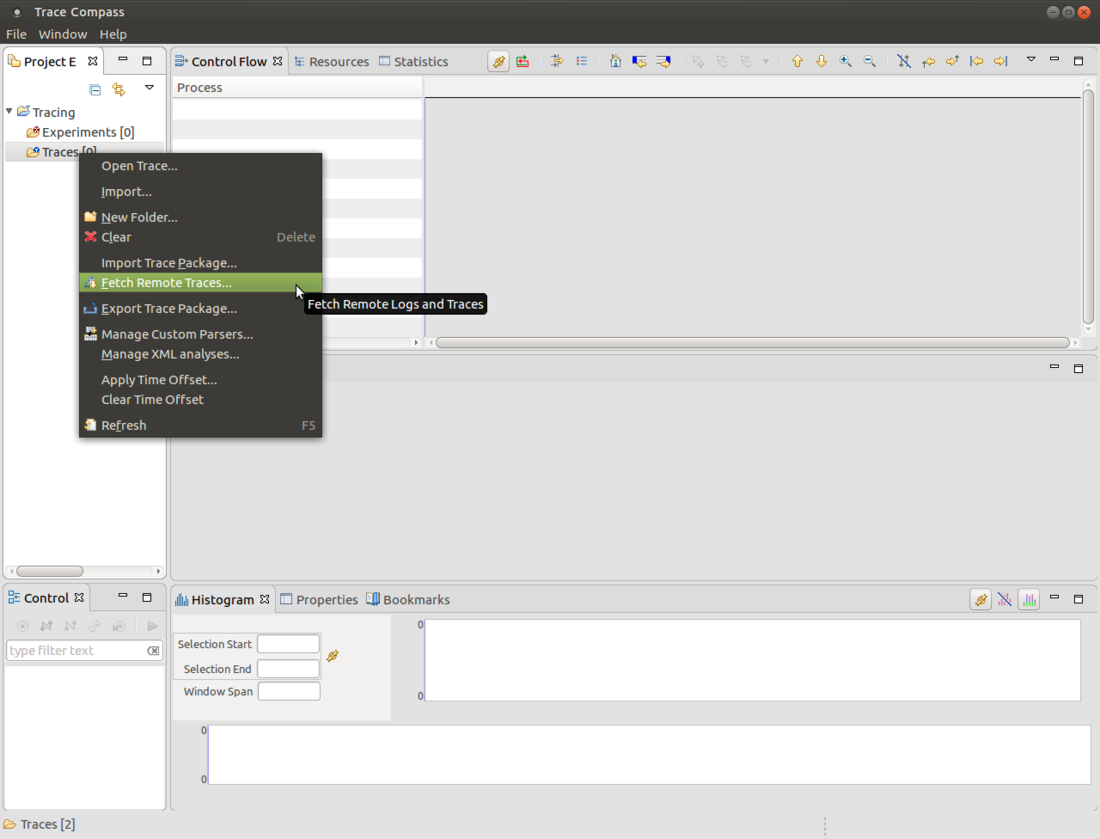
- Click on Manage profile to select/add the profile matching your setup (STBoards connection through ssh, ...)
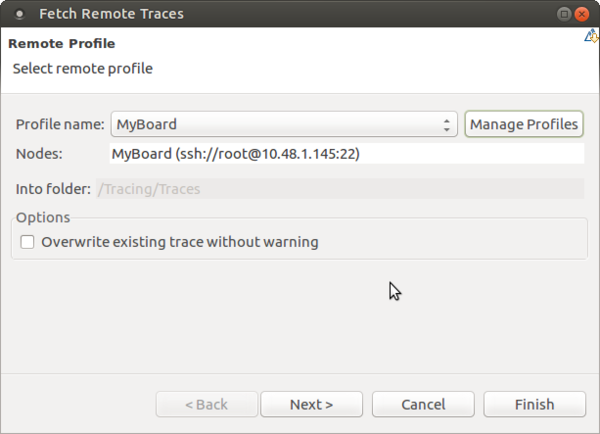
- If needed add a new profile: in this case, a profile named STBoards with ssh connection
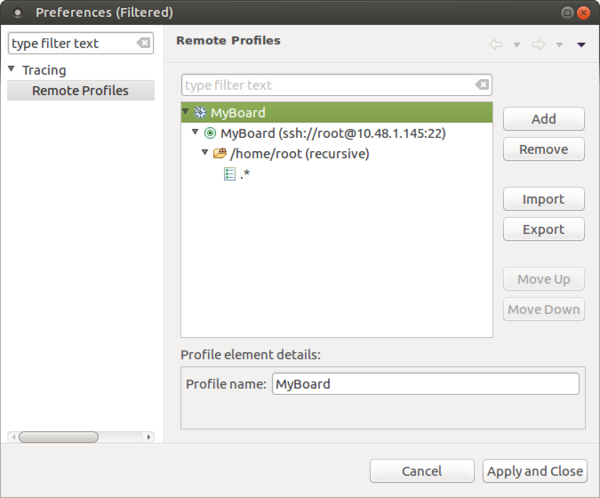
- Take care about the search path, by default Trace Compass looks for a wrong search path, please correct it
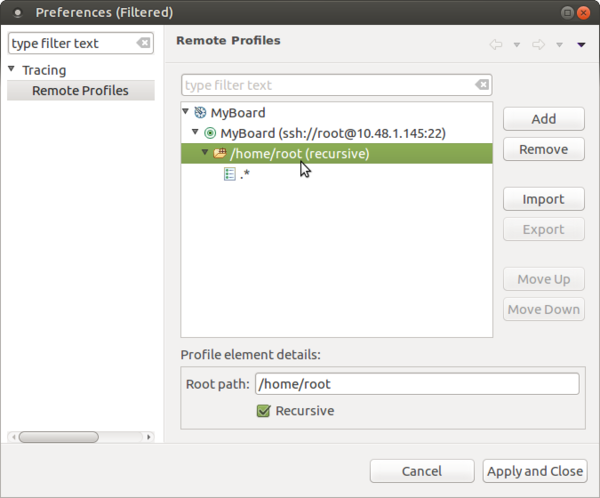
- End by clicking on finish button
Note that sometimes it fails to get logs at the first trial, do not hesitate to try again.
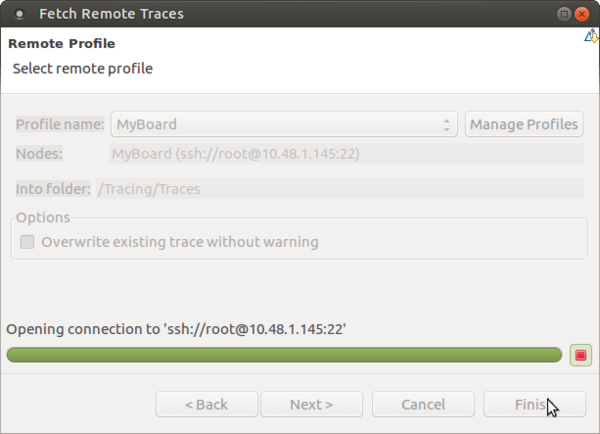
- Your traces will be loaded on Trace Compass, and you can see them on the Project explorer on the left.
In the example below 5 traces have been loaded:
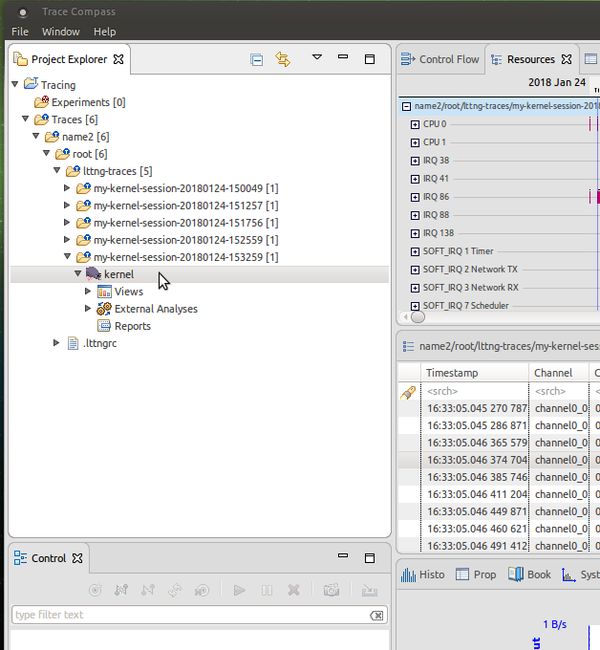
- Open the trace
To open the trace, left-click on the kernel item corresponding to your trace, then Open.
- Check for trace on the right panels
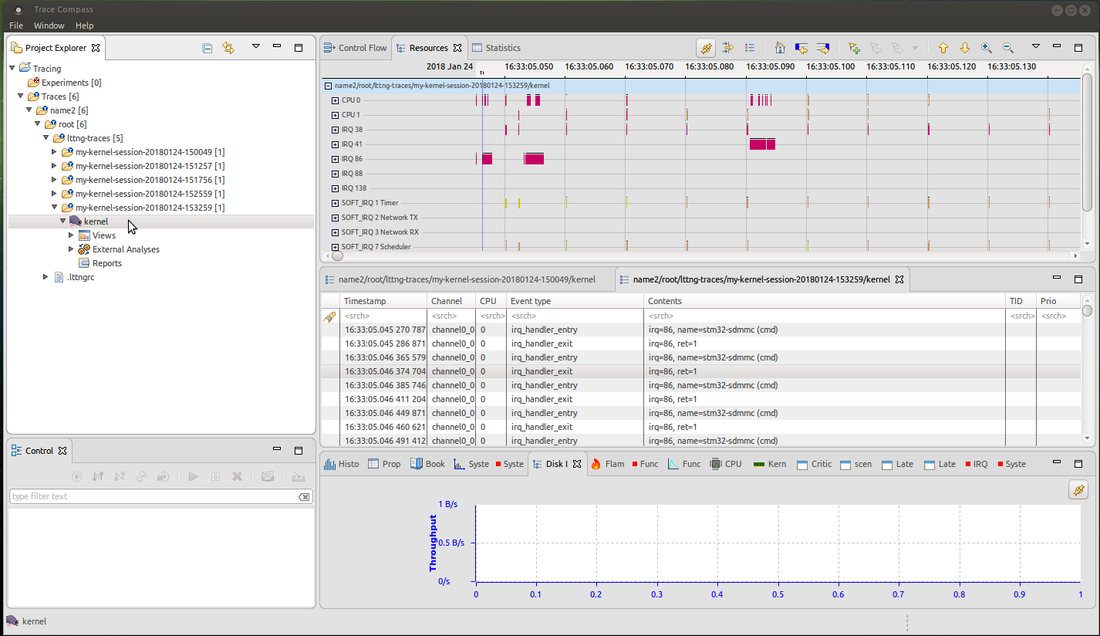
5. References[edit source]